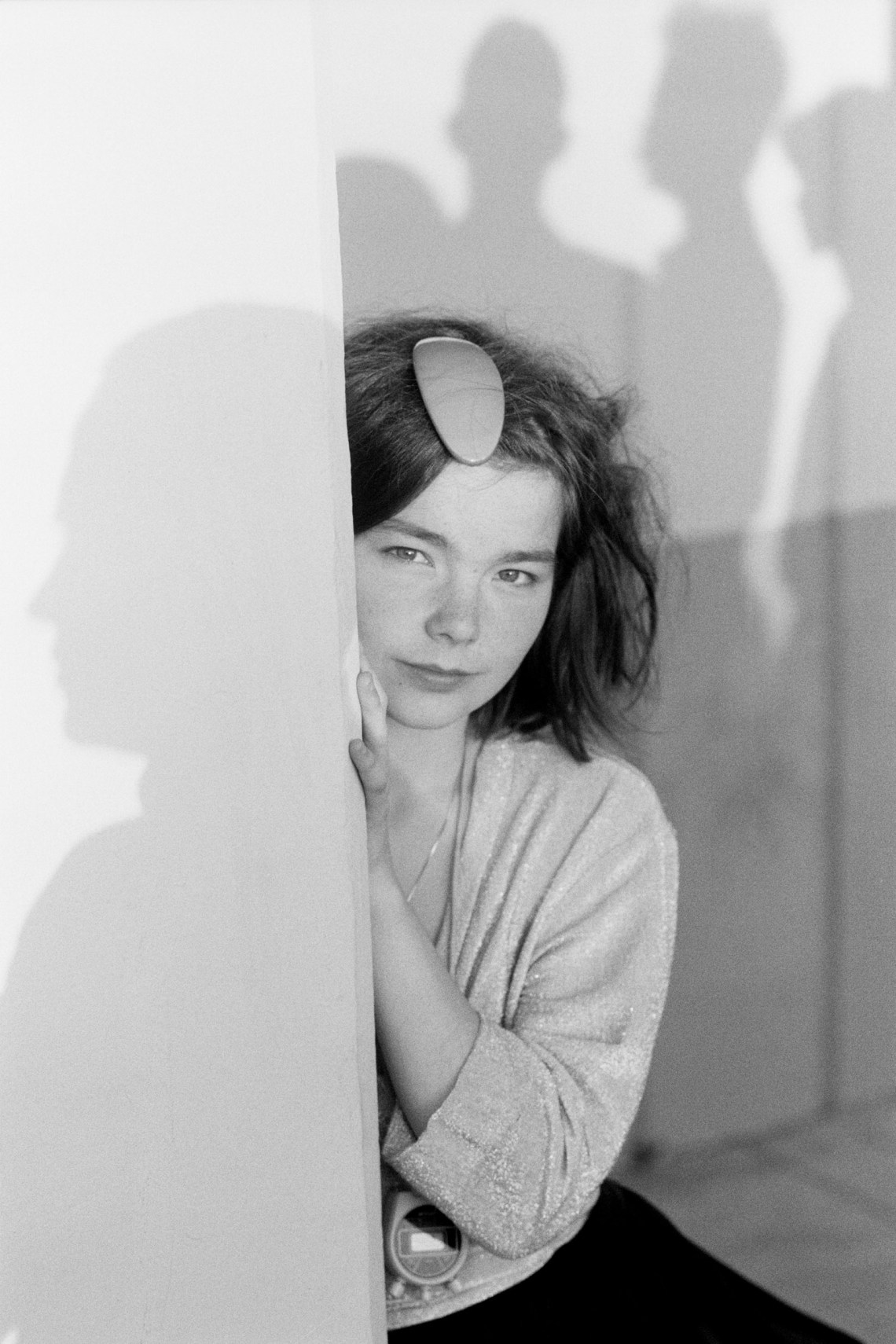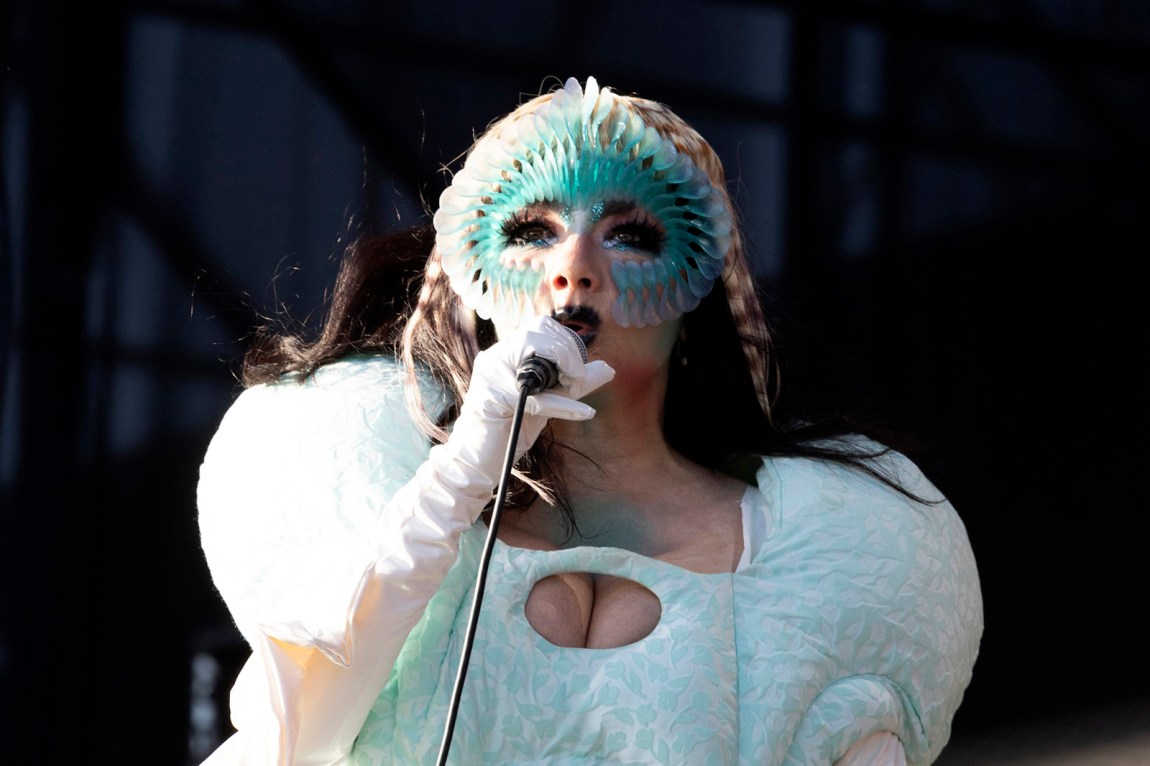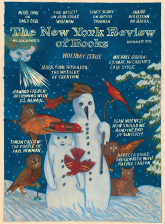Is anyone a Björk fan for life? Beginning with her 1997 album, Homogenic, the Icelandic singer and producer has put out records of such uncompromising intensity that it can be hard for even the most ardent fan to maintain enthusiasm over several years. If Björk’s early hits had the exuberance and ephemerality of the London club scene in which they were forged, Homogenic marked a turn to the stately, the formidable, and at times the intolerably self-serious. While one album could hit you squarely in the solar plexus, by the next the conviction that Björk alone understood your crisis would have passed, never to return.
Consider the cultural horizon over which Björk’s star first rose. It was, however briefly, the age of riot grrrl—which is to say it was a moment when music that explicitly billed itself as both punk and feminist was suddenly getting a lot of attention and, remarkably, a lot of airplay. Even performers who disavowed the name upheld the aesthetics: think of Courtney Love with her dirty dresses and torn stockings, or Liz Phair snarling over a poorly tuned guitar. Sloppy self-presentation sat alongside furiously confrontational lyrics—“Dead men don’t rape!” warned Seattle’s 7 Year Bitch—that drew sharp political commentary out of the sludge of intimate experience. Unfortunately, “the dominant experience,” as the scholar and prolific zinester Mimi Thi Nguyen has pointed out, “was whiteness,” meaning that for all its aggressive informality and impertinent abandon, this school of rock stopped short of admitting all comers.
Björk Guðmundsdóttir blew onto the scene with a wide-eyed naiveté that was highly marketable without being entirely manufactured, seeming to sidestep all the contradictions of the music business. Born and raised in Iceland, she could claim a pseudo-utopian innocence about race even as her first two albums were steeped in subgenres of electronic music—techno, acid, dubstep—pioneered by black artists in Detroit, Chicago, and London. As the former lead singer of the cheerfully shambolic Sugarcubes, she had punk credentials without punk politics, along with a classical education in piano and flute that made her seem at once more serious and more odd than the usual cast of MTV characters. She wasn’t angry. She was feral but sweet, cooing and gasping and warbling joyfully about the perplexities of human behavior as if she herself were another sort of creature entirely. On the cover of Debut (1993), she hides her elfin face partly behind her hands, cozy in a mohair sweater; on the winsomely titled Post (1995), she gazes serenely forward while standing in front of what looks like a giant pink lollipop.
Over time Björk took her casual idiosyncrasies and made them into something deliberate and adversarial. It’s worth comparing her, on this score, to her contemporary Missy Elliott, who has never enjoyed Björk’s highbrow cachet—remember that retrospective at MoMA?—but whose influence and significance are difficult to overestimate. Elliott’s single “The Rain (Supa Dupa Fly)” was released four months before Homogenic. In the video for that song Elliott famously wears an inflatable black vinyl bodysuit that turns her, in her words, into “a hip-hop Michelin woman”: strange and unbreakable. Like Elliott, Björk embraced a maximalism that seemed to insist on a woman’s right to be profoundly weird—not combative and unkempt but polished, eccentric, and theatrical. Unlike Elliott, however, she struggled to retain a sense of play, and her posture of perfect guilelessness could sometimes turn grotesque. For Homogenic’s cover she styled herself after a photograph of the Japanese American model Devon Aoki, wearing a futuristic kimono and digitally modifying the shape of her eyes. It is a jaw-dropping image, one that shows a tendency to prioritize drama over thought.
Musically, Homogenic remains astonishing. The theme is heartbreak; the argument is for murder. Björk’s formerly light-footed forest nymph stomps through the songs, alternately baying for her lover’s blood and sneering at his inadequacies. “What’s so scary?” she demands over beats programmed to sound like gunfire, “You can’t handle love!” In another song, the incomparable and terrifying “Bachelorette,” Björk is “a tree that grows hearts” and “the branch that you break.”
It’s on this record that she seems to have discovered the mimetic potency of her voice, which really can sound like a force of nature: as scathing as a gale-force wind, as determined as gravity. The Björk who once recorded a vocal track in the bathroom of a club, all depthless whispers and stall doors swinging in the background, is gone. In her place is a meticulous producer of Wagnerian ambition and gigantic feelings. She swoops, soars, gasps, and gurgles against a backdrop of stringed instruments and digital beeps and boops, on a mission of love and death, deliverance and revenge.
Advertisement
Björk has held at a rolling boil ever since. I’ll admit that the last of her albums I bought was 2001’s Vespertine, an epic catalog of admiring love for the artist Matthew Barney, whose work Anne Boyer brilliantly describes as “an inflictive yawp, the vulgar win of [one] who does a victory lap over pillage, who slam dunks the nightmare, who wears a cod piece jeweled with the pearls dived from the wreck.” Björk came to share this view, excoriating Barney’s “apocalyptic obsessions” along with his infidelity on Vulnicura, her 2015 album about the breakdown of their relationship. Utopia (2017), which she has referred to as her “Tinder album,” picked up where Biophilia (2011) left off, blending the earlier record’s ecological optimism with a revitalized sense of curiosity and confidence. Birds chirp, pipers pipe, and anyone who bought the album received $0.19 worth of cryptocurrency thanks to a partnership between Björk and the British blockchain company Blockpool.
Björk has always been a techno-utopian, starting from her early days of setting lyrics about trees, oceans, volcanos, and pulsating internal organs to music made by computers and including her later experiments (as on Biophilia) with creating digital instruments that listeners can play themselves via an app on their phones. With these sorts of juxtapositions she hopes, she’s said, to show how we might “live in the future with nature and technology in the most optimistic way possible.”
The environmentalist strain in her music has only grown more pronounced over time. When Thames and Hudson published the coffee-table book Björk: Archives to accompany that aforementioned (and much-derided) MoMA show in 2015, it included excerpts from her correspondence with Timothy Morton, an English professor whose whimsical books on climate change have found an audience in the art world. More recently she recorded a joint interview for the New Statesman with the nineteen-year-old climate activist Greta Thunberg, who politely describes Björk’s new album, Fossora, as “very cool.”
In that interview Björk explains that Fossora is an exploration of matriarchy, defined as “territory created from a woman’s point of view that is more inclusive, more pro-nature, pro-children, pro-hope.” Praising the younger generation for its progressive gender politics, she adds:
When I was a kid, it was just Kate Bush, and that was it—the rest was women entering guys’ worlds. I feel that I’m a typical example of a female, matriarchal musician, by which I mean I cannot just talk about me. We have a tendency to look at the whole picture, so I have to take in my children, my ancestors, the land.
This past September, Apple Music released Björk: Sonic Symbolism, a nine-episode podcast featuring Björk talking to her friends Oddný Eir and Ásmundur Jónsson (a philosopher and writer and a musicologist, respectively) about each of her albums in turn. It’s a fascinating series even if, like me, you’re not a diehard. With what she acknowledges as the wisdom of hindsight, Björk suggests that her turn to electronic music after her time with the Sugarcubes was a rejection of the macho sensibilities of rock and, for that matter, rock critics, with their unmasked disdain for musicians like Bush, whose attention to domestic detail—Björk mentions a negative review of Bush’s 2005 song “Mrs. Bartolozzi,” about clothes erotically spinning in a washing machine—makes them somehow “third class.” “It was OK,” she says, disgusted, “to write huge reviews about bands that were singing about tits and beer,” but “the inner life of the woman, the everyday life of a woman, was a lesser…art form.”
Whatever its themes, Fossora sounds pretty much like any other record Björk has made in the last two decades: it is neo-baroque electronica with a shade of rock opera. It distinguishes itself in being more emotionally dynamic, less eager to go for broke on every song. Tracks like “Victimhood” encourage us to interpret this musical circumspection as the result of some sustained soul-searching. (“Fossora” is a feminization of the Latin word fossor, or digger.) Here Björk tells herself to “step out of victimhood” and assume a “bird’s-eye view” that allows her to see even the most painful moments of life as ordinary and endurable. The song’s lugubrious soundscape, structured by the complaint of clarinets and an oboe, suggests a mood that is fading, and fade it does. The last fifty seconds are a cappella, Björk punctuating her own gentle humming with the sound of her voice reaching for the same handful of pitches over and over again, as if practicing her scales.
“Scale” might be a metaphor for the record as a whole. Fossora is interested in tacking between experiences of different size and articulating them in forms of different size. One song is less than one minute long; others stretch to seven. Some, like “Mycelia,” are performed by a one-woman band, just Björk and a software program; others are a grand affair, with ensembles of string and wind instruments led by the young Icelandic conductor Ragenheiður Ingunn Jóhannsdóttir. On “Allow,” Björk movingly exposes the frailty of her otherwise redoubtable voice in the upper registers, eventually letting it take a back seat to the crisper tones of singer Emilie Nicolas, who accompanies her. “Allow, allow, allow,” their voices rustle, “Allow me to grow.”
Advertisement
The most notable thing about Fossora, however, is that unlike Björk’s last several albums, it contains a masterpiece. The showstopping “Ancestress” is a eulogy for Björk’s mother, Hildur Rúna Hauksdóttir, an environmental activist who died in 2018. The verses shift gracefully between remembrance—“When I was a girl, she sang for me”—and vigil, as Björk describes doctors implanting a pacemaker into Hildur’s body and her mother’s loss of “manners” as she nears the end of life:
The machine of her breathed all night
While she rested
Revealed her resilience
And then it didn’t
You see with your own eyes
But hear with your mother’s
This is hard stuff but the song’s giant architecture holds it, the way that our social ceremonies of grieving—wakes, funerals, memorial services—help measure and give shape to the always unfinished ordeal of loss. “Ancestress” feels ancient, primal. Clocking in at a solemn sixty-seven beats per minute, it is also improbably catchy, rising and falling with a kaleidoscopic regularity that recalls medieval plainchant. Björk’s voice is sometimes alone, sometimes joined by that of her adult son, Sindri Eldon, as bells toll, strings sigh, and computers crunch numbers into sounds. “Did you punish us for leaving?” Björk asks, “Are you sure we hurt you?” Here is a genuine tribute and powerful catharsis, at once honest, sad, and replete with love.
Despite being the sort of musician who collaborates compulsively—she’s worked with Tricky, Timbaland, the electronic duo Matmos, and the harpist Zeena Parkins, to name just a very few—Björk, who is fifty-six, will probably always be thought of as an auteur, a slightly isolated whiz kid whose work is in thrall to some private, interior meaning. “Ancestress,” with its achingly personal subject matter, is as great as it is because it satisfies the desire for collective emotional experience in a way that only Björk’s first few albums, with their lighthearted, even disposable rhythms, really do. It’s a small step, perhaps, between the dance floor and the deathbed, but that’s no tragedy.
This Issue
December 22, 2022
Naipaul’s Unreal Africa
A Theology of the Present Moment
Making It Big





